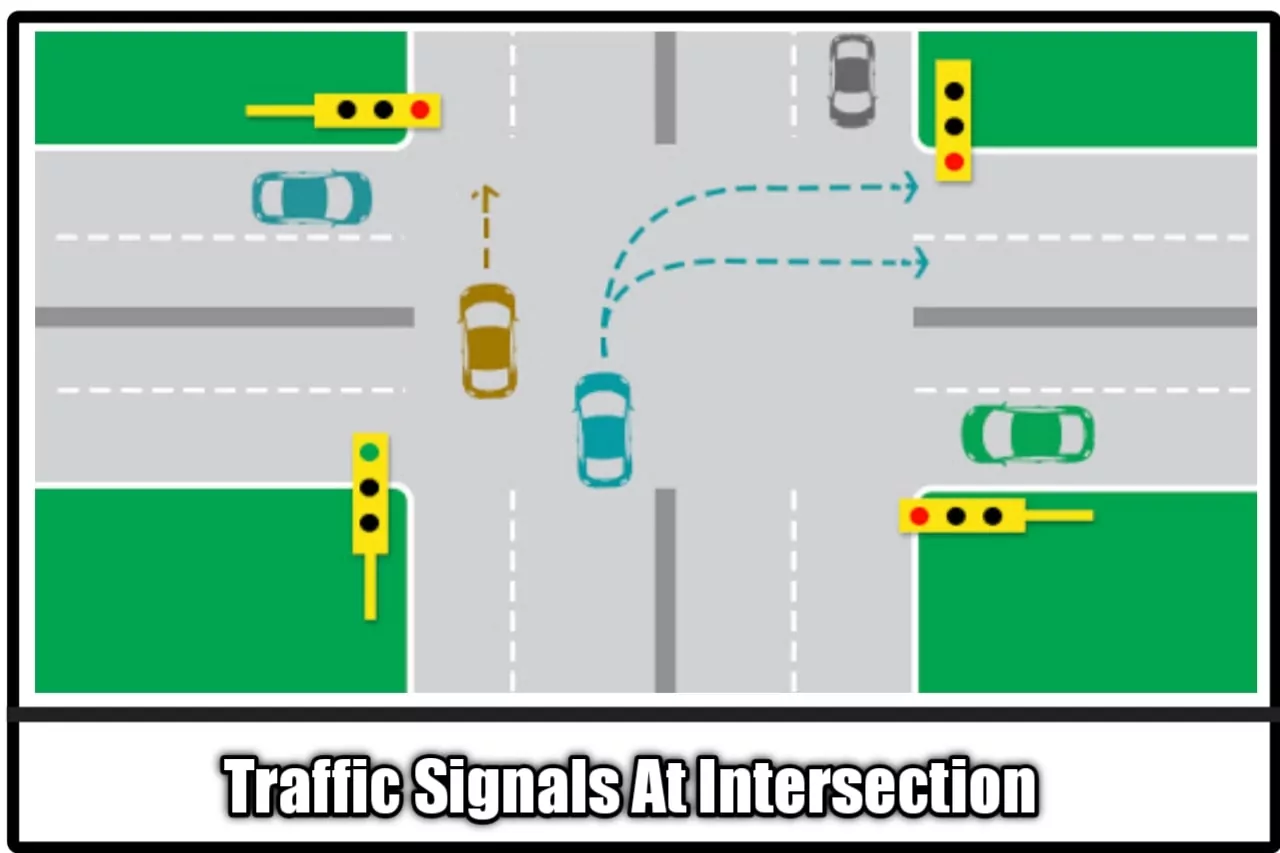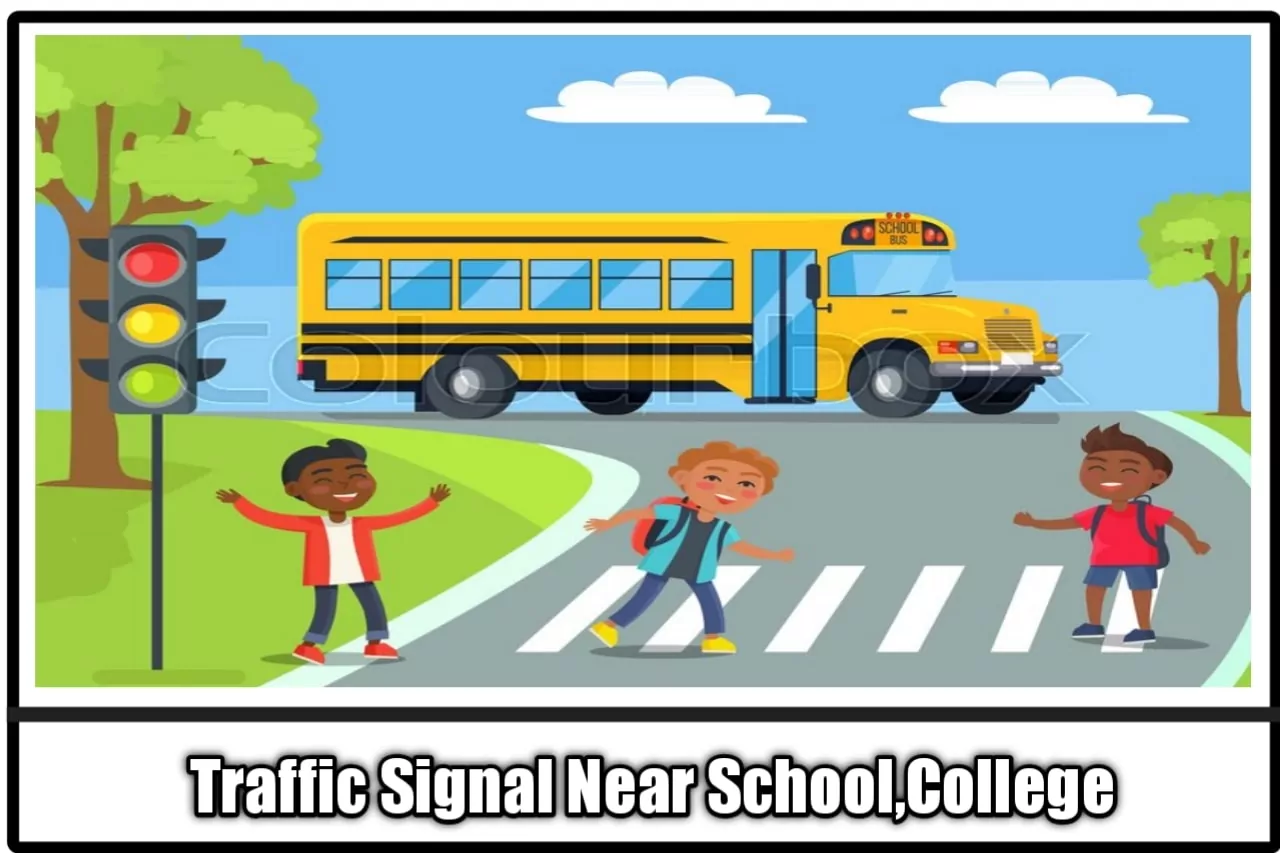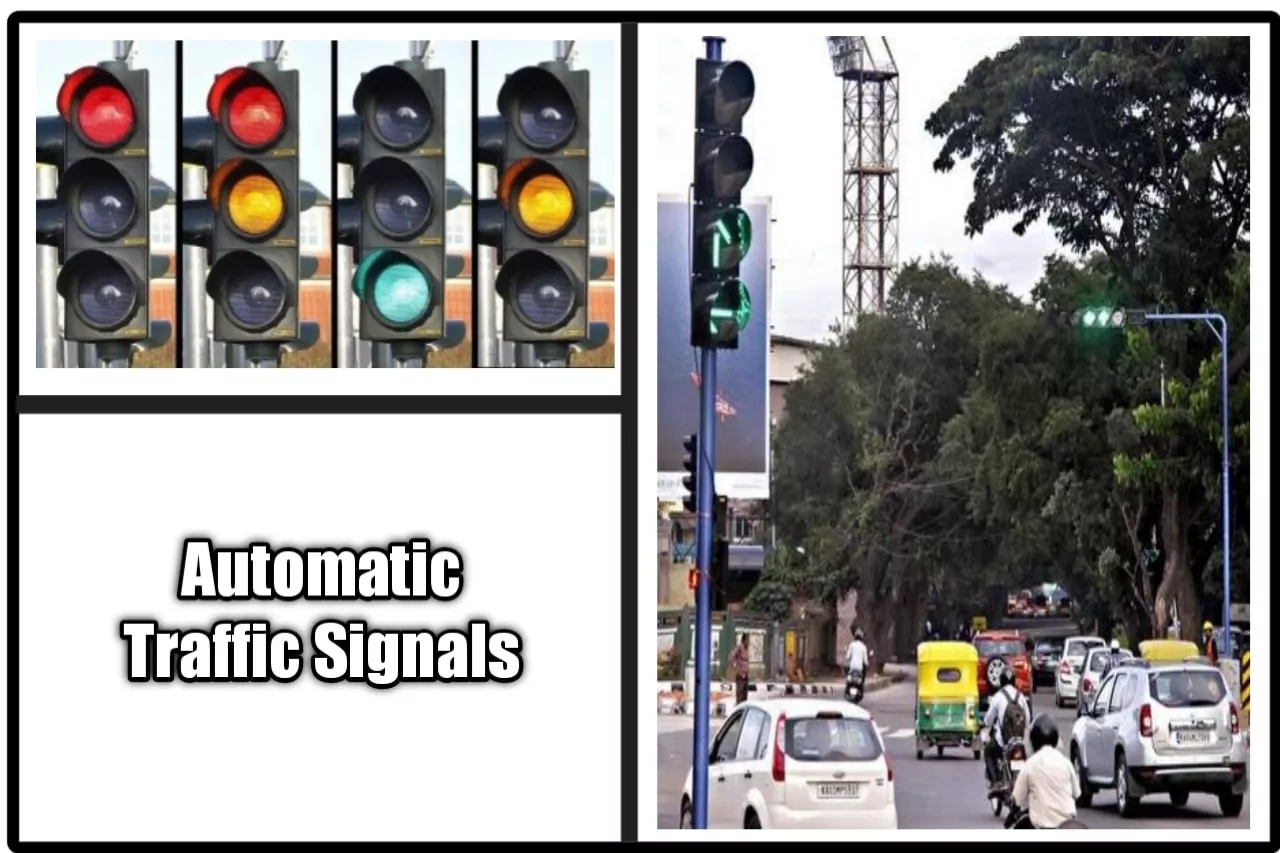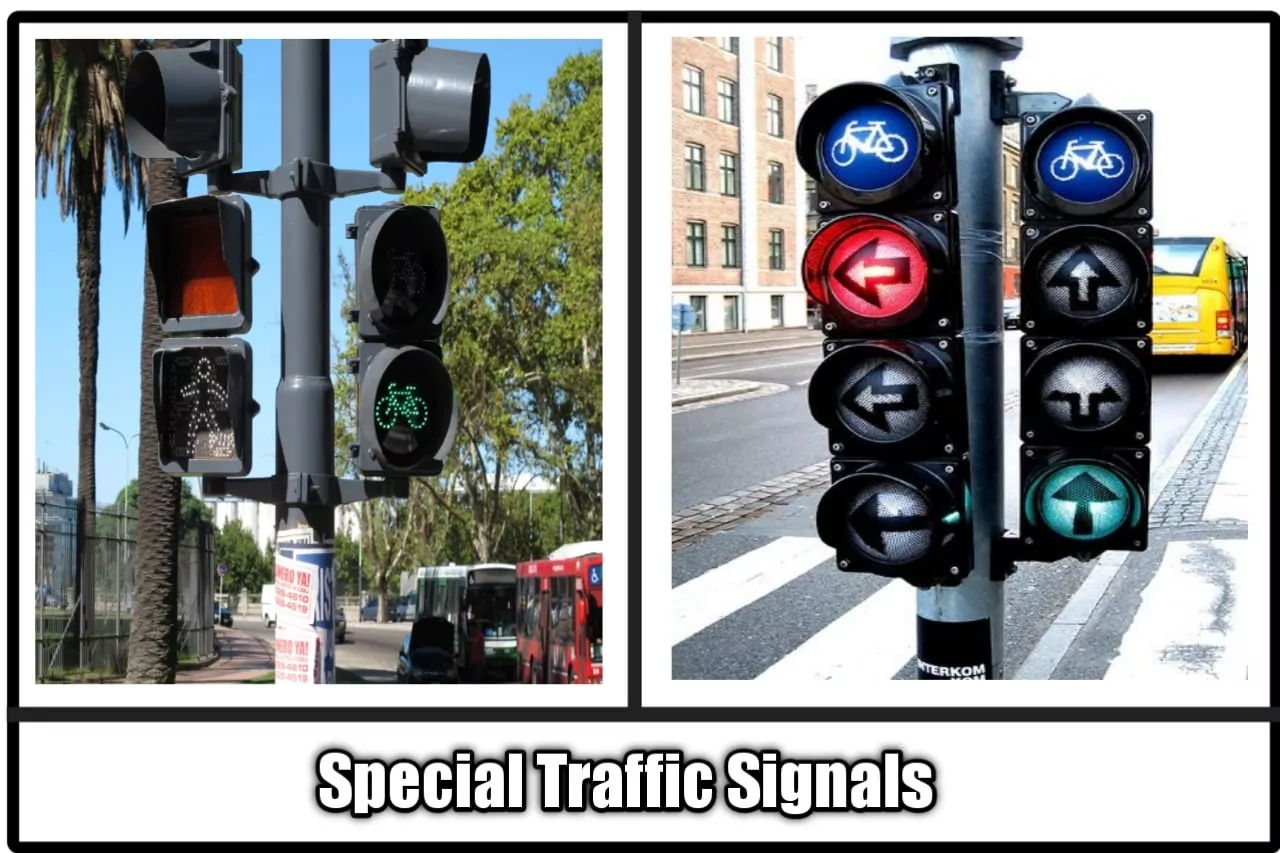Traffic signals are provided at road intersections and they are used as a control device for traffic. In this article, we will see all types of traffic signals which are widely used in all countries. lets first discuss what are the traffic signals?
Meaning of Traffic Signals
Traffic signals are provided at road intersections. These are control devices that could alternatively direct the traffic to stop and proceed at intersections using red and green traffic light signals automatically.
The main requirements of traffic signals are to draw attention, provide meaning and time to respond and to have a minimum waste of time. we also see what are the types of traffic signals
Basic Requirements of Traffic Signals :
(1) Attention
The signals must attract the attention of its users. Factors affecting attention are :
- Position of placing the signals
- Height of placing the signals
- The size of lamp lens (usually 200 mm diameter is used)
- Design of signal face and head.
- Background of the lens (generally dark background is required for lighted lens).
(2) Meaning
Each indication of signal should convey one and only one meaning clearly without any misinterpretation.
Red : Vehicle must STOP
Green : Vehicle can GO
Red Yellow (Amber) : Be ready to GO.
(3) Response
Yellow (amber) interval provides time required for response Since it takes time to stop a moving vehicle, an immediate change from green to red does not give time for response.
(4) Respect
The signals which are installed at a location should be useful to road users and they must be respected (liked) by them.
Where Traffic Signals Should Be Installed ?
At each and every intersection it is not necessary to install a traffic signal Such a general installation of traffic signals in fact would cause traffic congestion. Traffic engineering data should justify this installation.



The following recommendations are followed :
(i) The average traffic volume for eight hours on both approaches should be at least 650 motor vehicles per hour on a major street with a single lane and 850 vehicles on the streets with two or more lanes.
(ii) Minimum pedestrian traffic of 150 or more per hour should cross the major street with over 600 vehicles per hour on both approaches (1000 vehicles per hour in the case of the main street with raised median).
(iii) If there is an interruption of continuous traffic flow on the major road which carries 1000 to 1200 vehicles per hour or when there is undue delay or hazard to the traffic of 100 to 150 vehicles per hour m one direction only during any eight hours on an average day.
So to complete the above recommendations we have to study various types of traffic signals which are available in all countries.

Types of Traffic Signals
Generally, a traffic signal is composed of three lenses, arranged vertically one above the other with a red lens on top, yellow or amber in the middle, and a green lens at the bottom.
The normal sequence of the traffic signal is red, .amber, green, amber, red, and so on. The following are the indications are given by the colors of signal.
Red: Vehicles must stop
Amber: Lights about to change
Green: Vehicles can proceed.
here i have list out and explain types of traffic signals
The traffic signals are classified into the following types :
1.Traffic control signals
A. Fixed time signals
B. Manually operated signals
C. Traffic actuated signals
(i) Fully actuated signal
(ii) Semi-actuated signal
2.Pedestrian signals
3.Special traffic signals
lets discuss one by one types of traffic signals
1. Traffic Control Signals
These types of traffic signals are provided at different locations like intersection, circles, crossways. they are provided with three colors red, yellow amber, and green in facing the direction of traffic. The purpose of this color is mention above at the starting of the article.
This types of signal are further classified in to follow categories.
A. Fixed Time Signals :
These types of traffic signals are set to repeat regularly a cycle of red, amber, and green lights. The timing of each phase of the cycle is predetermined based on traffic studies. These signals are the simplest type of automatic traffic signals which are electrically operated. These signals are also called Pre-timed signals.

These types of traffic signals cannot take into account the fluctuations in traffic flow and so they are satisfactory where fluctuation is small. Different cycle times may be used to take care of morning peak, evening peak, and non-peak hour traffic, by using different cycle lengths during those hours. The cycle length varies from 40 seconds to 120 seconds.
Advantages of Fixed Time Signals:
- Simple in construction
- Relatively inexpensive
- Most successfully used in linked systems requiring a fixed cycle length for a given pattern and speed of progression.
Disadvantages of Fixed Time Signals :
- Inflexible and hence may cause an avoidable delay.
- Require a careful setting.
- Sometimes the traffic flow on one road may be almost nil and traffic on the crossroad may be quite heavy. Yet as the signal operates with fixed timings, the traffic in the heavy stream will have to stop at. red phase.
B. Manually Operated Signals :
In these types of traffic signals, the traffic police control the traffic demand from a suitable point during the high peak hours at the intersection and vary the timings of these phases and cycle accordingly.
This method used when their is vary low traffic which is handle by traffic police officers.

Advantages of Manually Operated Signals
- Use when there is low traffic
- No first investment
Disadvantages of Manually Operated Signals
- This method is costly too much.
- Running cost is high.
C. Traffic Actuated Signals [Traffic Automatics Signals] :
These types of traffic signals are those in which the timings of the phase and cycle time are changed according to the traffic demand. The vehicles on any intersection approach are sensed by a detecting device (e.g. magnetic tape, loops, or pneumatic pads) placed in the road. By recording the vehicles as they cross the detector and by timing the interval between vehicles, the signals are automatically adjusted to give preference to the approach with the heaviest flow.


Types of Traffic Actuated Signals :
These types of traffic signals are classified into following two types
(i) Fully actuated signal
(ii) Semi-actuated signal
(i) Fully actuated signal
These have detectors located on each approach and assign the right of way to the various traffic movements on the basis of demand.
(ii) Semi-actuated signal
Where traffic on a heavy volume of high-speed arteries must be interrupted for relative light class traffic, semi-actuated traffic signals are often installed. For these signals, the detectors are placed only on the minor street.
Advantages of Traffic Actuated Signals :
- Usually reduces delay.
- Usually increases the capacity.
- It is adaptable to short-term fluctuation in traffic.
- It provides continuous operation under low volume conditions.
- It is most efficient for isolated intersections.
Disadvantages Traffic Actuated Signals :
- They are uneconomical. The cost is about two to three times the cost of a fixed time signals.
- Detectors are very costly to install and present very difficult maintenance problems.
- The actuated controller (a complete electronic mechanism) is much more complicated than fixed time controllers.
2. Pedestrian Signals
These types of traffic signals are basically used for the pedestrian. These types of signals are provided on various locations like schools, colleges, offices, and many more.
This type of signals allow pedestrian to cross the road.

The Indian standard on traffic signals prescribes the following symbols for pedestrians. The RED standing man represents the don’t cross indication and the GREEN walking man represents cross indication.

3. Special Traffic Signals
These types of traffic signals are used to warn the traffic flow.
When there is a red flashing signal, the drivers of vehicles must stop before entering the nearest cross walk at the intersection or at a stop line where marked.
Flashing of yellow signals are used to direct the drivers of the vehicular traffic to proceed with caution.


General Principles of Signal Design
The main objective of the design of signalized intersection should be to provide sufficient capacity for the volume of traffic approaching the intersection. The design should aim at minimizing total delay, building short queues, and providing a high probability of passing through the intersection on the first given period for most users. Signal timing should be in accordance with traffic flow on the intersection. The cycle lengths are normally 40 to 60 seconds for a two-phase signal. Longer cycle lengths may be adopted for complex traffic flow and for more than two phases
Indian practice is Red-Green-Amber. The amber interval is a transition interval between the termination of the green movement and the exhibition of a red indication. The amber period is generally 3 to 6 seconds, and red/amber is usually 2 seconds.

(1) In general practice time for red signal provide sum of green and amber signal.
(2) Towards the end of the red phase, for a short duration amber light is put on along, with the red light signal in order to indicate ‘get set’ to go. This phase is called ‘red amber’ or ‘initial amber’. The vehicles are not supposed to cross the stop line during the red amber period.
(3) Clearance time or clearance amber phase is provided just after the green phase before the red phase, to fulfil two requirements :
■ Stopping time for approaching vehicle to stop at stop line after signal changes from
green to amber.
■ Clearance time for the vehicle which is approaching the stop line at legal speed while
the signal changes from green to amber.
(4) Green time or go time is decided based on the approach volume per week to enable the
queued vehicles to clear off in most of the cycles.
Various methods for design of fixed time signals are:
- Trial cycle method
- Approximate method
- Webster’s method
- IRC method
Advantages of Traffic Signals :
1. Maintain orderly flow of traffic
2. Reduce certain types of accidents.
3. Improves safety and efficiency of movement of vehicles.
4. Pedestrians can cross the roads safely
5. Provides nearly continuous movement of traffic
6. More economical than manual control
7. Stop heavy traffic to allow slow moving traffic to cross the road safely.
8. Increase in speed along the major road traffic.
Disadvantages of Traffic Signals :
1. The rear end collision may increase.
2. Improper design and location of signals may lead to violations of the control system.
3. Failure of the signal due to electric power failure or any other defect may cause confusion to the road users.
I Hope You Like Our Article “All 3 Types of Traffic Signals And General Practice of Design” Don’t be Cheap To Share This Article with your Friends.
READ MORE
1) 10 Types of Parking And How To carry Out Parking Study In Traffic Engineering ?
2) TRAFFIC VOLUME STUDY: How To Carried Out 10 Traffic Volume Studies In Traffic Engineering

